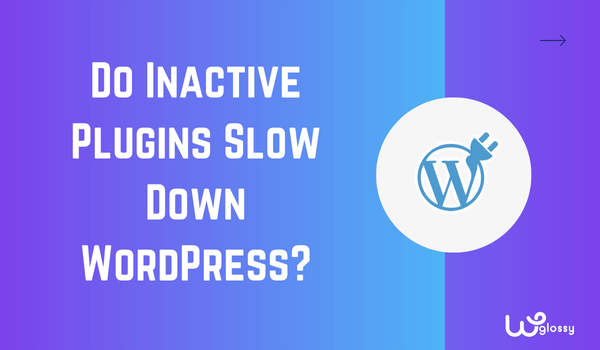
As a WordPress developer, followers and site readers have asked me several questions, such as whether inactive plugins slow down WordPress websites. Do too many plugins impact WordPress performance, even if deactivated?. My answer is NO, but that doesn’t make them SAFE.
In the last few years, I’ve seen several websites suffer from security vulnerabilities caused by outdated or inactive plugins. These plugins are often left in the directory, and website owners forget to remove or update them, which can become an open door for hackers.
But don’t worry! I’ll solve this issue once and for all by explaining how to completely remove these plugins from WordPress (even their files). I’ll also discuss the security issues these plugins pose in detail. Let’s get started!
Are Unused Plugins Bad For WordPress Speed?
No, inactive plugins do not slow down the WordPress website site because they’re inactive or deactivated. This means their data isn’t executed on WordPress, and if it’s not in a loading process (execution), it won’t affect the site’s speed.
Here’s a simple explanation (the technical part of how WordPress works):
WordPress begins the loading process whenever a user wants to access a page from the website. This means WordPress executes the files and codes necessary to display a web page. The more files WordPress has to process, the longer the website will take to load.
However, inactive plugins aren’t part of this process because they are deactivated at the user’s request. WordPress skips over inactive plugin files and only focuses on active or necessary plugins that contribute to generating page content.
This is why inactive plugins do not slow down WordPress websites. But just because they don’t affect the site doesn’t mean they’re harmless. From my experience, they can cause serious security issues if left unattended.
Should I Delete Inactive WordPress Plugins?
Absolutely! Although they’re harmless when it comes to loading speed, they may create serious security issues.
My developer friend recently shared an experience where his client noticed suspicious activities on the website. After digging, he found that the cause was an inactive plugin that had not been updated for a long period of time. Unfortunately, it’s normal for me, as I encounter similar issues every other day.
In fact, many plugins in the past have been identified as a security risk!
One example is a 2016 security report that exposed a cross-site scripting vulnerability in the W3 Total Cache plugin. Cross-site is an attack in which a hacker injects a malicious script into the code of the website, plugin, app, etc. These scripts are then loaded into the browser, leading to some security issues.
Even though the deactivated plugins are inactive, their files still exist on your server. If any of those plugins have vulnerabilities, hackers can exploit them through the loopholes, and you will lose the site control. That’s why removing inactive plugins is always a good idea.
How To Remove Inactive WordPress Plugins?
Now that you’ve decided to delete the inactive plugin, let me share the methods with you.
Method #1 – Delete Plugin by Plugin
The first method is to delete the inactive one by one. This is the best method if you want to remove one specific plugin from WordPress. To do this:
Login to the WordPress website and choose “Plugin” within the navigation menu.

All plugins, whether they are active or inactive, will appear on the dashboard. You’ll see a checkbox alongside all plugin names. Click on the checkbox next to the plugin you want to delete.

After selecting the plugin, scroll to the top of the page and choose “Delete” and “Apply.” This will delete the selected plugin from WordPress.
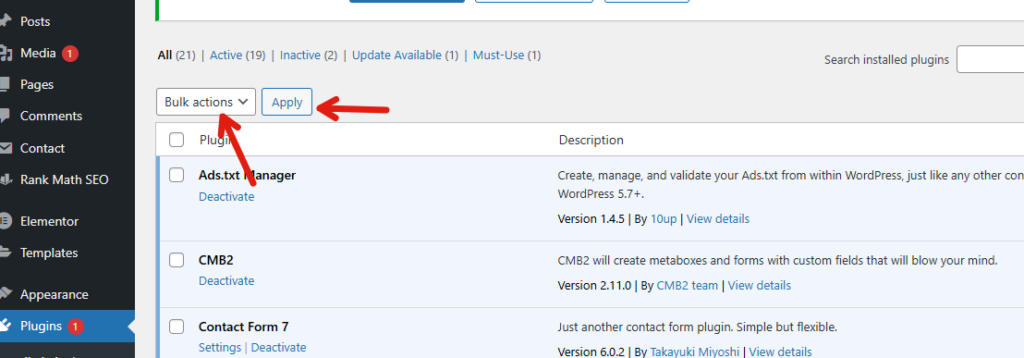
Method #2 – Delete All Plugins
The bulk selection is the best option if you have a long list of inactive plugins and the useful plugins are only a few to name. In this situation, click on the checkbox alongside the “Plugins.”
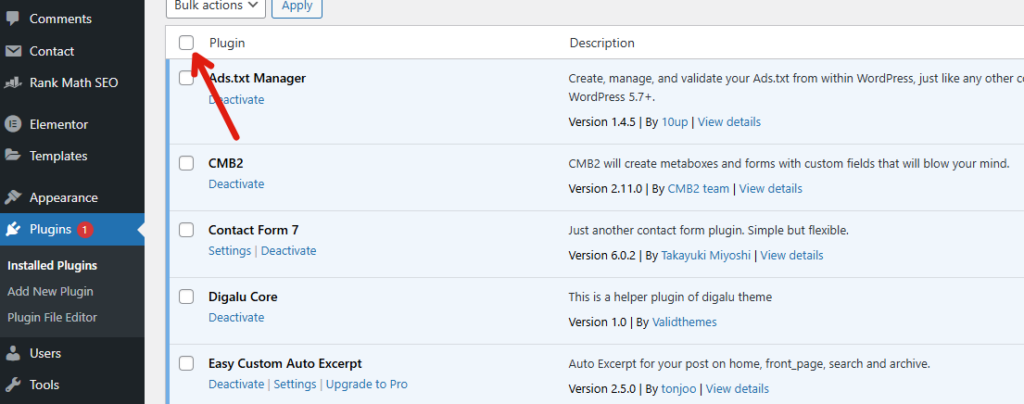
Once you’ve selected all plugins, scroll down and uncheck the ones you don’t want to delete. Then go to the top of the page and choose “Delete” and “Apply.”
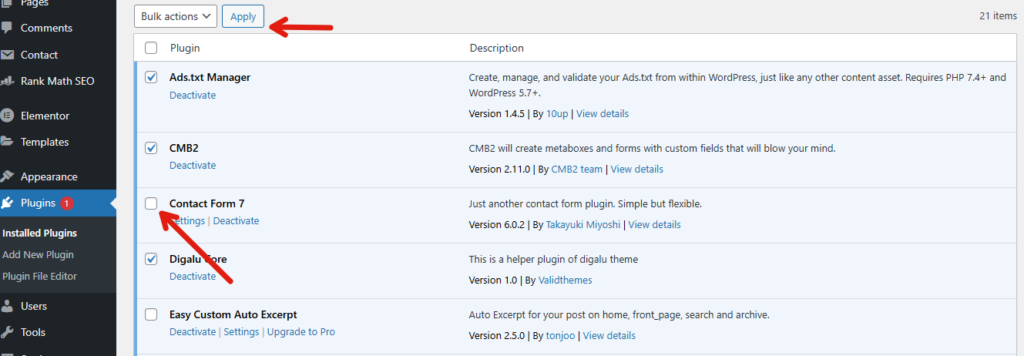
How To Completely Delete Plugin Files and Data From The Database?
Wait, deleting the plugin from the WordPress dashboard isn’t enough (as many people do). By doing so, you only delete the plugin from the dashboard, not the files and data from the WordPress database.
Over time, these leftover files can pile up and slow down the website. I’ve been dealing with this when troubleshooting performance issues for clients. Here’s how I handle it:
Method #1 – Delete the Plugin Folder From phpMyAdmin
- Login to the cPanel of the website and choose “phpMyAdmin” to access database files.
- Choose the database associated with the website you want to modify.
- In the database, navigate to the Structure tab.
- Search for the plugin by entering its name (e.g., Yoast) in the search bar.
- Select the plugin’s folders or entries, then delete them to remove the plugin data from the database.

Method #2 – Delete The Plugin Folder From File Manager
- Log in to the cPanel of your website and open File Manager.
- Locate and open the public_html folder.

- Head over to the wp-content folder.

- Next, open the plugins folder.
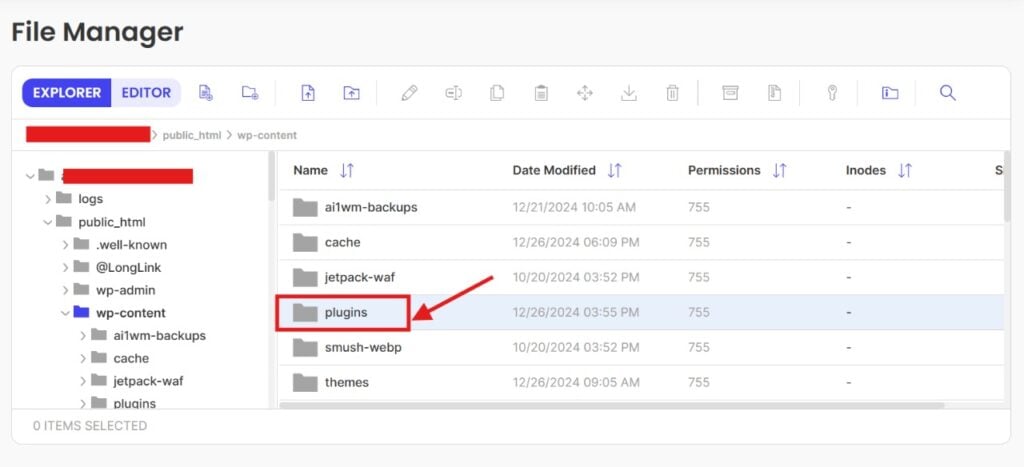
- Select the folder of the plugin you wish to remove and delete it.
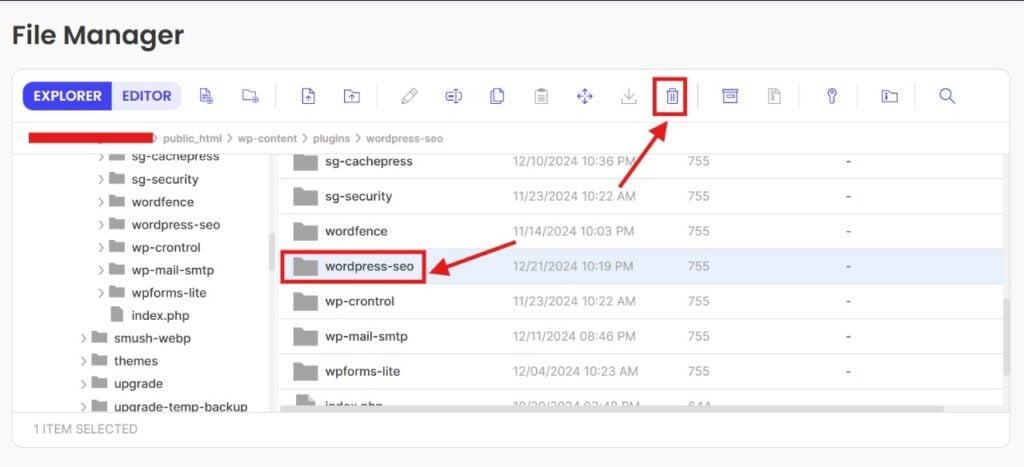
BONUS TIP – You can also clean the database using the “Advanced Database Cleaner” plugin. This is the best option, as you can locate the database tables and files using the WordPress dashboard. There’s no need to manually access the “phpMyAdmin” database.
Frequently Asked Questions (FAQs)
What happens when you deactivate a WordPress plugin?
When you deactivate a WordPress plugin, WordPress immediately stops running the plugin’s file and code. The plugin remains installed, but its functionality is disabled until you reactivate it.
How many plugins are too many on WordPress?
There’s no hard and fast rule about how many plugins you should install. You can install 10, 20, or even 30+ plugins, but ensure they’re all safe, updated, and necessary for the website. If there is a plugin that you don’t need, remove it (you can always install it again).
Does deactivating a WordPress plugin delete data?
No, deactivating or deleting the WordPress plugin from the dashboard doesn’t remove plugin data. The data is saved on the database backend. To remove it, use a plugin such as Advanced Database Cleaner or remove the files manually from phpMyAdmin.
What is my Conclusion About Inactive WordPress Plugins?
Simply put, the answer to “Do inactive plugins slow down WordPress?” is a NO. However, that doesn’t make them harmless either. As I explained, they pose serious security threats, so I suggest removing them and deleting their files from the database.
If you’re not ready to remove the plugin, you should monitor it regularly for updates. You can ensure that all inactive plugins are secure and not outdated by checking updates. I do this, and so far, it has helped me maintain secure and optimized websites for my clients.

can you please tell me about akismet plugin and jet peck? I think these 2 plugins also slow down our website.
Yes, Jetpack is a heavy plugin, I don’t recommend it. But you can use the Anti-spam plugin, Askimet. It will not slow down your WordPress site. Thanks for reading the article. Let me know if you need any WordPress-related help.
Great insights! I always wondered if inactive plugins affect site speed. Your explanation clears up the confusion—super helpful for WordPress users. Thanks for sharing this valuable info!
I keep too many inactive Plugins and the article made things quite clear that wordpress doesnt slow but they pose security threats. so it mean we should remove them and keeping them is not a good idea. Thank you
Yes, you are correct!
Great insights on inactive plugins and their impact on WordPress performance! I always wondered whether keeping deactivated plugins would slow down my site. Your explanation about database clutter and security risks is really helpful.
From my experience, regularly cleaning up unused plugins and optimizing the database has improved my website speed significantly. I also found that using a lightweight theme along with caching plugins makes a big difference.
I recently shared some tips on optimizing website performance. Would love to hear your thoughts on it! Thanks for the valuable content.
Hi Kirti,
Thanks for your comment. Great to know about your plugin experience. I’ll visit your blog and share my feedback.